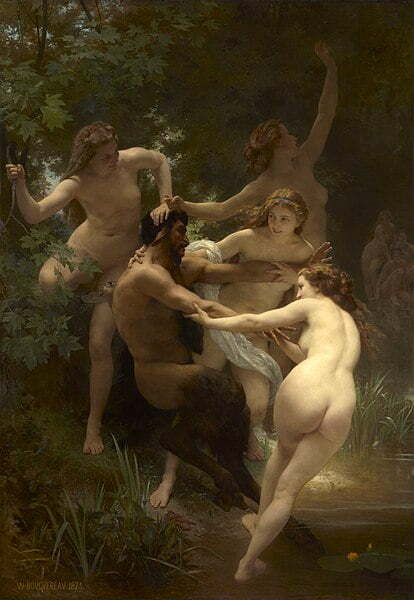Creature Types, Fey (the fair folk)

A fey is a creature with supernatural abilities and connections to nature or to some other force or place. Fey are usually human-shaped.
Songs of the Sidhe by David Ross
Fey are the dominant life-forms in Faerie, although they are not as numerous as animals, plants, or vermin. All fey have a bond of some kind to an external force. Most are clearly bonded to nature generally or to some specific part of it; even those few fey who do not at first appear to be nature-bound (such as zeitgeists) are commonly thought to share in it indirectly.
The precise qualities of a bond vary from individual to individual, race to race, and world to world – dryads die if parted from their trees, while satyrs merely have a knack for encouraging reproduction in other creatures. In nearly all cases, keeping in touch with nature in whatever way suits them can give fey power in a number of ways. In turn, nature may depend on fey for the way it functions.
In some cases, nature exists only by the work of the fey and would fall into ruins without their influence. Gods of nature or other primal entities might play a similar role, but in general these are less effective than the fey because they lack the fey’s reach or aptitude.
In an ecology like this, removing the spirits behind it ‘be they fey or gods’ would be like pulling the soul from a body, quickly killing it. Without guidance, the natural world would quickly lose cohesion and might even unravel into its component elements, energies, and alignments.
On a smaller scale, killing a dryad might likewise kill her tree. If a Faerie Lord of Summer like this were murdered, his world would simply not experience summer until a new fey took up the Lord’s mantle. In Ladinion, many of the mightiest fey (particularly archfey) have this type of bond. If such an archfey dies, his realm may soon collapse into a tempest of churning climates, terrains, and magical forces until it finds a stable equilibrium with its surroundings.
In other cases, nature depends on the fey for its efficiency but not its function. Without guidance, things become unhinged and degrade but do not fail altogether. For example, if a patch of marsh depends this way upon an enclave of local fey, the extinction of the enclave might cause the bog to suffer chronic dry spells or frequent population imbalances (causing food shortages, plagues, or extinctions).
Elements, energies, and alignments can become unbalanced or misplaced. If such an archfey of Autumn were dethroned, that world’s autumns would still occur, but would also be fraught with some unseasonable weather and other problems until a new archfey claimed the portfolio of Autumn. The majority of Ladinion’s fey have this style of relationship with the environment.
In still other cases, nature derives only its supernatural elements from fey magic. In a case such as this, a mountain without the oread bound to it ceases to manifest her beneficence or her capriciousness, but does not otherwise change or degenerate. If an evil and vindictive Queen of Winter of this sort were slain, her world’s winters would remain as normal, but they would no longer reflect her wicked spite (perhaps those who do not placate the Queen would no longer tend to be killed by extreme weather). The regions of Ladinion with the lowest fey populations, such as where Fomorians and linnorms rule, often demonstrate this independence from fey bonds.
A fey has the following features.
- d6 Hit Die.
- Base attack bonus equal to 1/2 total Hit Dice (slow progression).
- Good Reflex and Will Saves.
Skill points equal to 6 + Intelligence modifier (minimum 1) per Hit Die. The following are class skills for fey: Acrobatics, Bluff, Climb, Craft, Diplomacy, Disguise, Escape Artist, Fly, Knowledge (geography), Knowledge (local), Knowledge (nature), Perception, Perform, Sense Motive, Sleight of Hand, Stealth, Swim, Use Magic Device.
Traits: A fey possesses the following traits (unless otherwise noted in a creature’s entry).
- Low-Light Vision.
- Proficient with all simple weapons and any weapons mentioned in its entry.
- Proficient with whatever type of armor (light, medium, or heavy) it is described as wearing, as well as all lighter types. Fey not indicated as wearing armor are not proficient with armor. Fey are proficient with shields if they are proficient with any form of armor.
- Fey breathe, eat, and sleep.
- Fey Senses
- Fey Metabolism
- Fey Reproduction
- Brughs
- Extreme Spaces and Liminal Spaces
- Fey Aging
- Fey Death
Songs of the Sidhe by David Ross
While most fey races have their own cultures, these cultures are mostly offshoots of the greater whole of common fey society. Of all creature types, fey come closest to having a shared culture and worldview. The most basic underpinning of this shared culture is a result of their shared biology: all fey are beings linked to some external force, to a greater or lesser extent. As a result, even the most selfish and aloof of fey cannot escape the influence of the thing to which they are bound. Each is by definition a part of something larger than itself.

 Buy me a coffee
Buy me a coffee